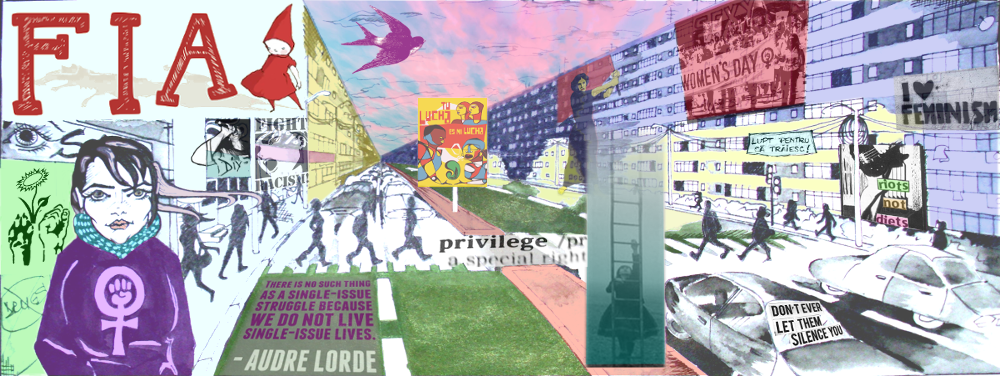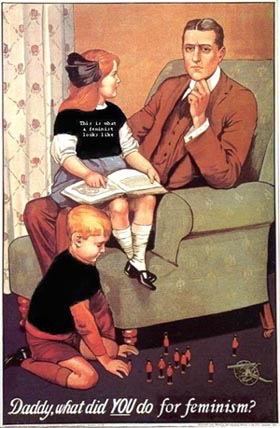Two comments on some international press coverage of the Virginia Tech shooting that does the usual victim-blaming, woman-bashing thing:
—from Emma
… [British tabloids] have a penchant for the scarlet lady, the vile temptress, the fallen woman. […] It seems they’ve found another one. The most nauseating of their endless, masturbatory speculation seems to have fixated on the young woman who was the first victim. Headlines include this from the Metro – a paper so bad they give it away for free:
“The Girl who Lead to a Massacre”
[subsequently changed, possibly due to reader outrage, to the marginally better “Was it an obsession with Emily that drove gunman to kill?”, although the article still begins with “This is the face of the teenage student who may have sparked the biggest gun massacre in US history.”]
I’m physically shaking as I type this. I am so damn angry. This is but one headline, typical of the tabloid press today, particularly those owned by the D**ly M*il. The sneering implication behind all of them is that this “vibrant girl with an engaging personality” had brought this horror down on all the victims, by rejecting the romantic/sexual advances of the murderer. This is the overwhelming message spun by our gutter press in the UK.
I’m appalled. I’m ashamed.
—and from Jennifer
I wrote to someone last night after I heard about this young woman’s murder and said that I expected the media to once again blame women for this man committing murder. Little did I know my view would be proven true within less than 24 hours.
This young woman did not cause her own death or the deaths of so many others. The one whose photo or at the very least name which should have appeared is the man who pulled the trigger. This man took revenge on the young woman because she dared to end her relationship with him.
This man was not a ‘loner’ neither was he isolated – rather he reacted as so many other men have done – by murdering a woman because he believed she belonged to him utterly. The authorities themselves dismissed the first shootings as ‘just a domestic’ until such time as more males were being murdered. Such is the total disregard for any woman’s life.
Now all the focus is on gun laws – very cleverly omitting the fact it is was not guns but how so many males continue to be socialised into believing they are entitled to control and dominate any woman who happens to come into their lives.
[similarly, the headline and sub-headline for the story in the Australian Daily Telegraph were “Was gunman crazed over Emily?” and “THIS is the face of the girl who may have sparked the worst school shooting in US history.” next to a picture of her.]
… Not only does this headline sexualise the poor woman it also portrays the male gunman as being driven crazy by this young woman’s supposed irresistible sexuality. The only person responsible and to blame for these murders is Cho Seung-Hui. He took a decision to pull the trigger and the media is deliberately attempting to deflect attention away from yet another case of male violence against women. The media would be advised to ask questions concerning how boys and men are socialised into what is termed dominant masculinities which in turn normalises and justifies male violence against women and children.
(see also article by Jennifer on End Violence Against Women blog)
It’s a very good thing that readers are complaining about the callous, disrespectful stance of the media towards this female victim. Unfortunately, by way of “apology” (?) the Daily Telegraph staff hypothesizes that reader outrage may be due to “some cultural confusion between the US and Australia” or the fact that “the hurt and devastation of this event [is] so monumental that people need to vent their anger and confusion at something, anything” – commenting nothing about the problem itself, nor taking responsibility for their misstep (they probably figure victim blaming happens all the time and it’s so accepted, as is misogyny in general, that it’s unfair for readers to pick on them specifically). Apparently, they are in a similar conundrum with reader reaction to a racial slur published in one of their articles yesterday… and they’re just as shocked that someone complained. Of course.
—-
more at Feministe
—-
on a very different note (ABOUT LIVIU LIBRESCU)
—-
and more:
“Virgina Tech Massacre: Blame Feminism!” – Andi Zeisler, WIMN’s Voices
Add “mass murder” to the ever-growing list of societal problems that can be pinned on feminism. In this appalling article from the UK’s Times Online, Sarah Baxter posits quite confidently that last week’s carnage is the fault not of Cho Seung-hi, but of the shameless hussies that comprised Virginia Tech’s female population — women who dared to have sexual relationships, spurn the advances of creepy dudes, and speak their minds when they felt harassed. Those uppity little sluts! Of Cho’s first victim, Emily Hilscher, Baxter writes:
“Perhaps there was something about her that reminded Cho of another girl he had fancied — the one he had sneaked into the women’s dorm to see but, as a roommate recalled, “When he looked into her eyes, he saw promiscuity.”
Such assertions wouldn’t be complete without the rubber-stamp of an expert, of course—and whaddya know, here’s Camille Paglia, bringing her characteristic brand of victim-blaming “logic” to an explanation of why the slaughter of Emily and 31 others really isn’t Cho’s fault …
“Mass Murderers and Women: What We’re Still Not Getting About Virgina Tech” – James Ridgeway, Mother Jones
Of all the lessons contained in the horror at Virginia Tech, the one least likely to be learned has to do with the deadly danger posed by the dismissive way we still view violence against women.
The first person killed by Cho Seung-Ho, a freshman named Emily Hilscher, was initially rumored to be Cho’s current or former girlfriend – the subject of his obsession or jealous rage. It now appears that she never had a relationship with Cho, but the rumors were spread quickly, especially by blogs and by the international tabloid press. The UK’s Daily Mail headlined the “Massacre Gunman’s Deadly Infatuation with Emily,” while Australia’s Daily Telegraph published a photo of a smiling Hilscher with the line “THIS is the face of the girl who may have sparked the worst school shooting in US history.” (The page is still up.) Some accounts stooped to suggesting, with zero evidence, that the victim had jilted Cho, cheated on him, or led him on.
More significantly, local police and university administrators appear to have initially bought this motive, and acted accordingly. In the two hours between the murders of Hilscher and her dorm neighbor Ryan Clark, and Cho’s mass killings at another university building, they chose not to cancel classes or lock down the campus. (They did choose to do so, however, in August 2006, when a man shot a security guard and a sheriff’s deputy and escaped from a hospital two miles away.) Virginia Tech President Charles Steger said authorities believed the first shooting was a “domestic dispute” and thought the gunman had fled the campus, so “We had no reason to suspect any other incident was going to occur.” The assumption, apparently, is that men who kill their cheating girlfriends are criminals, but they are not crazy, not psychopaths, and not a danger to anyone other than the woman in question. (Or, as one reader commented at Feministe sarcastically, “Like killing your girlfriend is no big deal.”)
In fact, these attitudes ignore past evidence of both “domestic disputes” and a more generalized misogyny as motives in mass killings. Multiple murders in homes and workplaces often begin with a man killing his wife or girlfriend. Mark Barton, who in 1999 shot nine people in an Atlanta office building, began the day by bludgeoning to death his children and his wife; six years earlier he had been a suspect in the death of his first wife and her mother, who were also beaten to death. In another high-profile case, the December 1989 mass shooting at Montreal’s Ecole Polytechnique, Marc Lepine was after women, whom he hated, and had a list of feminists he wanted to kill. He murdered four men and 14 women, and wounded 10 more women. In September 2006, Duane Roger Morrison walked into Platte Canyon High School in Bailey, Colo., and took six female students hostage, killing one. And last October, Charles Carl Roberts IV took over an Amish schoolhouse, let the boys go, and killed five girls.
One warning sign in such cases is a history of stalking and harassment of women. At Virginia Tech, in September 2005, poet Nikki Giovanni had Cho removed from her class at Virginia Tech after female students complained that he was using his cell phone to take pictures of their legs underneath the desks; some refused to come to class while Cho was there. In November and December of that year, two female students reported receiving threatening messages from Cho, and one said he was stalking her. But charges were never filed, and police and university officials didn’t seem especially worried about the women. Yet, as Arlen Specter pointed out in comments on the VT shooting made during the Gonzalez hearings Thursday, Cho had been accused of a “crime against the state as well as against the students,” and the local DA could have taken up the case.
According to the Stalking Resource Center, one million women are stalked in the U.S. every year. In two-thirds of the cases where a female victim asks for a police protective order, that order is violated. Earlier this month, Rebecca Griego, a researcher at the University of Washington, was murdered in her office by her ex-boyfriend after she had reported his threats to the university police and Seattle police, changed her phone number, moved out of her apartment, distributed photos and descriptions of her stalker, and sought an order for protection.
One third of female murder victims are killed by an intimate partner (as opposed to about 3 percent of male victims). Of these, 76 percent had been stalked by the partner in the year prior to their murder. Murder ranks second (after accidents) as the leading cause of death among young women. And if the Supreme Court and abortion opponents really want to protect the lives of fetuses, they might consider this: Murder is the number one cause of death of pregnant women in the United States. …



